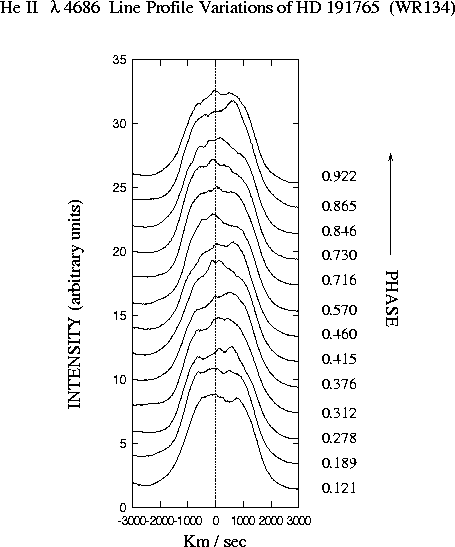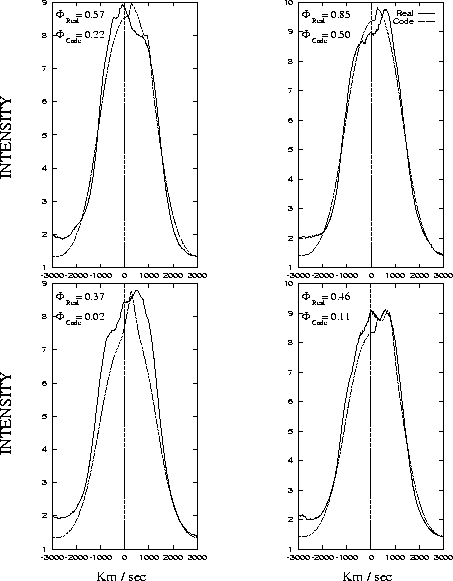1: Instituto Nacional de Astrofisica Optica y Electronica, Apodo. Postal 51, Puebla, Pue. 7200, Mexico
2: Instituto de Astronomia. UNAM, Apodo. Postal 70-264, Mexico D. F. 04510, Mexico
HD 191765 is a Wolf-Rayet star with a high degree of variablity in its emission lines, is a controversial star because some models which based in the results of monitoring with different observational techniques have been proposed for the description of the physical mechanisms that induce the variability. Assuming the star to be a binary star, we have been able to make a direct comparison between high resolution observational HeII ![]() 4686 line profiles and synthetic profiles calculated with the code for "atmospheric eclipses" of Auer & Koenigsberger (1994).
4686 line profiles and synthetic profiles calculated with the code for "atmospheric eclipses" of Auer & Koenigsberger (1994).
HD 191765 (WR134) is a Wolf-Rayet star (WRs) which based on their emission line profile variations and from the analysis of their photometric data, was proposed to be a WR+cc system (Antokhin et al. 1982) . However, recent intensive monitoring with different observational techniques, has given rise to alternative explanations for the variability in these WRs include the presence of a disk (Shulte-Ladbeck et al. 1992), rotating jet-like structures (Vreux et al. 1992), and corotating interaction regions (Morel et al. 1998). In order to resolve whether or not binary interaction
effects can be responsible for the line profile variability being observed,
numerical simulations generated under the assumption of this interaction
must be generated and compared with the observations. Koenigsberger (1995)
showed that the line profiles produced under the binary assumption were
qualitatively similar to those observed in the WR+collapsed companion
candidate HD 50896. In this poster we
present a comparison between the line profiles computed assuming orbital
motion and atmospheric eclipses with observations of HD 191765 (WR134).
The effect on the line profiles due to orbital motion and atmospheric eclipses is
computed as in Auer and Koenigsberger (1994). The intrinsic line profile arising
in the WR wind is calculated using the Sobolev approximation in those portions
of the wind in which this approximation is valid. In the regions of slower
acceleration, the equations of radiative transfer are solved exactly.
For the profiles presented here, a linear velocity law was employed.
The WR emission line is assumed to remain constant throughout the orbital
cycle, and the wind is assumed to be
spherically symmetric. The companion is assumed to have an associated
Gaussian emission line which follows its orbital motion. The input
parameters are described in Table 1, which also contains the values we
have used for these parameters in this test case.
The calculated profiles are produced on a trial-and-error basis, by systematically
modifying the input parameters until a reasonably good fit to a reference
observed profile is obtained. Because the basic assumption is that the
variations are due to the presence of a companion, an assumption must be
made regarding which of the observed line profiles most resembles one which
we could assign to a specific orbital phase. Once this reference spectrum
is identified, and the input parameters of the code are defined, synthetic
spectra are generated for the other orbital phases, corresponding to the
available observational data for comparison (in Figure 3, is seems synthetic spectrum superposed on the real spectrum) . Phase zero corresponds to the companion "in front" of the WR star (see Figure 1). Differences between
the observed and the computed line profiles can be attributed to
effects which are not considered in the computer code, such as line formation
in a shock cone, non-spherically symmetric mass loss from the WR star, and
intrinsic variability (including clumping) in the WR wind.
The observations were obtained at the 2.1m "Guillermo Haro Observatory" (OGH)
in Cananea Sonora, during various observing runs during 1997-1998.
The high S/N (![]() 300) and reciprocal dispersion (0.31
300) and reciprocal dispersion (0.31 ![]() /pix) at the HeII 4686
/pix) at the HeII 4686![]() allow a good comparison with the computed models, (in Figure 2, He II
allow a good comparison with the computed models, (in Figure 2, He II ![]() 4686 line profiles are ordered in phase).
4686 line profiles are ordered in phase).
|
 |
 |
1.- The simple model of a binary system in which both components have associated emission arising in spherically symmetric line-forming regions is capable of reproducing some of the observed profiles, but not all. The differences between the observed and predicted line profiles indicate that:
a) Mc Candliss period is incongruent with the real period of variability in the line profiles
b) line emission arising in a shock cone surrounding the companion needs to be incorporated;
c) non-spherically symmetric line forming regions are required;
d) wind instabilities play a major role in the shape of the upper
portion of the line HeII ![]() 4686 profile and are not the result
of the presence of a possible binary companion.
4686 profile and are not the result
of the presence of a possible binary companion.
2.- This star shows a greater degree of variability on the upper portions of the line profile on timescales shorter than 2.5 hrs.
3.- Is necessary to establish a well defined period with our set of spectral data.
Auer. L. H., Koenigsberger, G. 1994, Apj, 436, 859
Antokhin, I. I., Asianov, A. A., Cherepashchuk, A. M. 1982, Soviet Astronomy Letters, vol 8, 156
Koenigsberger, G., 1995, in: K. A. van der Hucht & P. M. Williams (eds.), Wolf-Rayet Stars: Binaries, Colliding Winds, Evolution, Proc. IAU Symp, No. 139, p. 538
Mc Candliss, S. R., Bohannan, B., Robert, C., & Moffat, A. F. J. 1994, Ap & SS, 221, 155
Morel, T. 1999, Apj, submitted
Shulte-Ladbeck, R. E., Meade, M. R. 1992, in: L. Drissen, L., C. Leitherer, & Nota, A. (eds.), Nonisotropic and Variable Outflows from Stars, ASP Conf. Series 22, 118
Vreux, J. M., Gosset, Bohannan, B., Conti, P. 1992, A & A, 256, 148